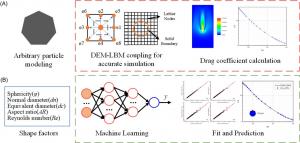Flow of the future: AI models tackle complex particle drag coefficients
GA, UNITED STATES, November 4, 2024 /EINPresswire.com/ -- Researchers have made a groundbreaking advance in fluid dynamics, using machine learning to accurately predict the drag coefficients of complex-shaped particles. This technological leap promises to significantly enhance our understanding of how particles behave in fluid flows, a key aspect in various industrial and environmental processes.
Accurately modeling particle movement through fluids is crucial in fields ranging from chemical engineering to aerospace. The drag coefficient, which influences how particles settle and move in fluid environments, is a core factor in these calculations. While the behavior of spherical particles is well understood, predicting the drag coefficient of irregularly shaped particles has long been a challenge. These complexities have highlighted the need for a more sophisticated approach to model particle-fluid interactions, especially for non-spherical particles.
A team from Nanjing University of Science and Technology and Westlake University addressed this issue by integrating machine learning with advanced numerical methods. Their study (DOI: 10.1002/msd2.12124), published in International Journal of Mechanical System Dynamics on August 27, 2024, combines the discrete element method (DEM) with the lattice Boltzmann method (LBM) to create a high-accuracy dataset. This data was used to develop four machine learning models aimed at predicting the drag coefficient of polygonal particles, with one model achieving a prediction error of less than 5%, a significant step forward in fluid dynamics research.
The research addresses the long-standing challenge of predicting the drag coefficient of irregularly shaped particles. Traditionally, single shape factors have been insufficient to capture the complex details that influence particle behavior. By using DEM and LBM simulations, the researchers generated a precise dataset that allowed them to develop multiple machine learning models. The genetic algorithm-artificial neural network (GA-ANN) model outperformed the others, reducing the prediction error to under 5%. This breakthrough demonstrates the effectiveness of machine learning in improving the accuracy of particle-fluid interaction models.
Professor Cheng Cheng, one of the lead researchers, noted, "This study showcases the immense potential of machine learning to solve complex fluid dynamics problems. By leveraging numerical simulations and artificial intelligence (AI), we’ve reached an unprecedented level of accuracy in predicting the drag coefficients of polygonal particles, which could have far-reaching impacts in both academic and industrial settings."
This ability to predict drag coefficients with such precision has wide-ranging applications across industries such as chemical processing, environmental engineering, and aerospace technology. Enhanced drag prediction models can improve processes like sedimentation, filtration, and propulsion, making systems more efficient. The findings from this research are expected to lead to advancements in fluid-particle interaction designs, with broad potential to optimize various industrial systems.
DOI
10.1002/msd2.12124
Original Source URL
https://doi.org/10.1002/msd2.12124
Funding information
This study was funded by the National Natural Science Foundation of China, Grant/Award Number: 11972194.
Lucy Wang
BioDesign Research
email us here
Legal Disclaimer:
EIN Presswire provides this news content "as is" without warranty of any kind. We do not accept any responsibility or liability for the accuracy, content, images, videos, licenses, completeness, legality, or reliability of the information contained in this article. If you have any complaints or copyright issues related to this article, kindly contact the author above.

